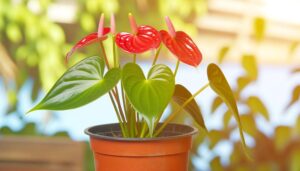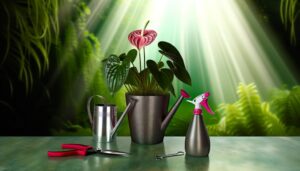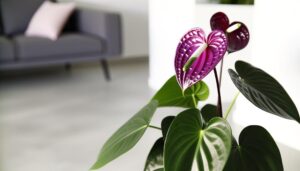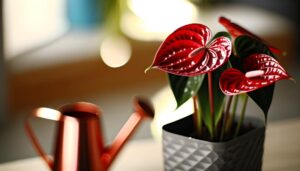Complete Guide to Caring for Anthurium Red Gunsal
To care for your Anthurium Red Gunsal, place it in bright, indirect sunlight and avoid direct sun exposure. Water when the top inch of soil dries out, keeping the soil lightly damp but not waterlogged.
Maintain humidity between 70% and 80%, and keep temperatures stable between 65-80°F. Fertilize every two weeks in spring and summer, reducing frequency in autumn and stopping in winter.
Use sterilized shears for pruning and repot every 1-2 years. Monitor for pests and diseases, using neem oil or insecticidal soap as needed.
To optimize plant health further, explore additional care tips and troubleshooting techniques.

Key Takeaways
- Place Anthurium Red Gunsal in bright, indirect light and avoid direct sunlight to prevent leaf burns.
- Water when the top inch of soil is dry, keeping soil consistently damp but not waterlogged.
- Maintain humidity levels between 70% and 80% and use room-temperature water to avoid plant shock.
- Fertilize every two weeks in spring and summer, reduce to once a month in autumn, and stop in winter.
- Inspect regularly for pests and diseases, using neem oil or insecticidal soap as needed.
Choosing the Right Location

When selecting the right spot for your Anthurium Red Gunsal, make certain it receives bright, indirect sunlight to imitate its natural habitat. This tropical plant thrives in conditions where it’s protected from direct sun, which could burn its leaves.
Consider placing it near an east or north-facing window, where it gets ample light without the danger of harm. Guarantee the spot maintains a stable temperature, ideally between 65-80°F. Avoid placing it near drafts or heating vents, as sudden temperature changes can strain the plant.
Monitoring humidity is essential; aim for 60-80% to keep its leaves vibrant. By choosing the perfect location, you’ll create an environment where your Anthurium can flourish, mirroring the lush, tropical settings it naturally prefers.
Light Requirements
Understanding the light needs of Anthurium Red Gunsal is crucial for ensuring its healthy development and vibrant foliage.
This tropical plant thrives in bright, indirect light. Place it near a window with filtered sunlight, but avoid direct sunlight, which can scorch its leaves. If natural light is inadequate, consider using a grow light to replicate the ideal conditions. Aim for 10-12 hours of light daily to promote optimal growth.
Monitor the plant’s reaction to its light environment. Yellowing leaves can indicate excessive light, while leggy growth suggests insufficient light. Adjust positioning accordingly to maintain equilibrium.
Consistency is crucial; sudden changes in light exposure can stress the plant. By carefully managing light conditions, you’ll nurture a flourishing Anthurium Red Gunsal.
Watering Schedule

To establish a best watering schedule for your Anthurium Red Gunsal, start by evaluating soil moisture levels regularly.
Aim to keep the soil consistently damp but not waterlogged, which can lead to root rot.
Water the plant when the top inch of soil feels dry to the touch, ensuring even hydration.
Optimal Watering Frequency
Ensuring ideal watering frequency for your Anthurium Red Gunsal involves carefully monitoring soil moisture levels and environmental conditions.
Generally, you’ll want to water when the top inch of soil feels dry. But remember, the frequency can change with seasons and indoor climate. Use the table below for guidance:
| Season | Frequency | Notes |
|---|---|---|
| Spring | Every 5-7 days | Increased growth phase |
| Summer | Every 3-5 days | Higher evaporation rate |
| Fall | Every 7-10 days | Slower growth, cooler temperatures |
| Winter | Every 10-14 days | Dormant phase, reduced water need |
Always use room-temperature water and avoid oversaturation. By staying mindful and consistent, you’ll keep your Anthurium thriving.
Soil Moisture Levels
Monitoring soil moisture levels plays a pivotal role in establishing a reliable watering schedule for your Anthurium Red Gunsal. You’ll want to keep the soil consistently moist but never waterlogged.
Insert your finger about an inch into the soil; it should feel slightly damp. If it’s dry, it’s time to water. Use distilled or rainwater to avoid mineral buildup. Water thoroughly until it drains from the bottom, guaranteeing even moisture distribution.
During warmer months, check moisture levels more frequently as evaporation rates increase. Conversely, reduce watering in cooler months when growth slows. Overwatering can lead to root rot, while underwatering can cause leaf browning.
Regularly checking moisture levels assures your Anthurium thrives, maintaining its stunning, vibrant foliage.
Humidity Needs
Anthurium Red Gunsal thrives in an environment with humidity levels between 70% and 80%. To achieve this, you can employ several methods to maintain ideal humidity. The plant’s natural habitat is tropical, requiring consistent moisture in the air for healthy growth.
- Use a Humidifier: Place a humidifier near your Anthurium to keep humidity levels stable.
- Pebble Trays: Fill a tray with water and pebbles, then place the pot on top to increase humidity through evaporation.
- Grouping Plants: Cluster your Anthurium with other houseplants to create a micro-environment of higher humidity.
- Regular Misting: Mist the leaves with distilled water to provide immediate moisture, but avoid waterlogging the soil.
These methods will help your Anthurium flourish in a home environment.
Ideal Temperature
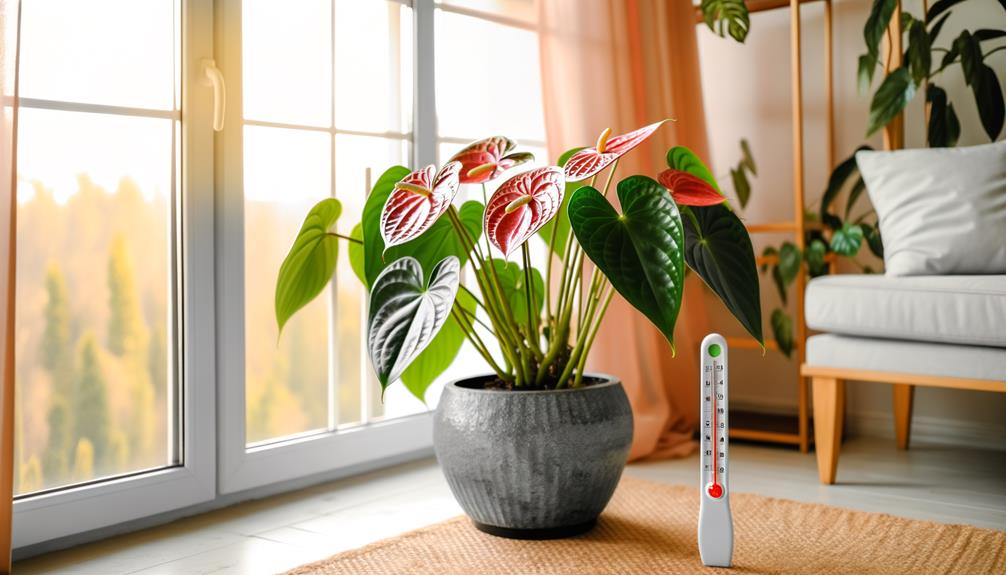
Maintaining a consistent temperature range between 65°F and 80°F is important for the best growth of your Anthurium Red Gunsal. This tropical plant thrives in warm conditions, mimicking its native environment.
Avoid exposing it to temperatures below 60°F, as this can stress the plant and hinder its growth. Sudden temperature fluctuations can also be detrimental, so keep it away from drafty windows or heating vents.
Nighttime temperatures should ideally not drop more than 10°F from daytime highs. If you live in a cooler climate, consider using a heat mat to maintain consistent warmth.
Regularly monitor the room’s temperature with a reliable thermometer, ensuring your Anthurium enjoys a stable, nurturing environment for optimal health and vitality.
Fertilizing Tips

To guarantee your Anthurium Red Gunsal thrives, use a balanced, water-soluble fertilizer with an N-P-K ratio of 20-20-20.
Apply the fertilizer every six to eight weeks, adjusting the frequency during the growing and dormant seasons.
Monitor the plant’s response and make necessary changes to avoid over-fertilization.
Choosing Optimal Fertilizer
Selecting the right fertilizer for your Anthurium Red Gunsal involves understanding its specific nutrient needs, which are best met with a balanced, water-soluble formula high in phosphorus. This nutrient is essential for promoting vibrant blooms and robust root systems. Look for a fertilizer with an N-P-K ratio like 10-30-10 or 15-30-15.
To enhance effectiveness, consider these tips:
- Dilution: Always dilute the fertilizer to half the recommended strength to prevent root burn.
- Application: Apply the fertilizer directly to the soil, avoiding the leaves.
- Timing: Fertilize during the growing season for best absorption.
- Organic Options: Explore organic fertilizers like fish emulsion for a gentler nutrient release.
Frequency of Application
Understanding the frequency of fertilizer application for your Anthurium Red Gunsal is important to make sure it receives consistent nutrients without overloading the soil.
You’ll want to fertilize this plant every six to eight weeks during its active growing period. Use a balanced, water-soluble fertilizer diluted to half the recommended strength.
Over-fertilization can lead to nutrient burn, while under-fertilization may stunt growth. Always water your Anthurium thoroughly before applying fertilizer to avoid root damage.
Keep an eye on the plant’s foliage; yellowing leaves can indicate nutrient deficiencies, signaling it’s time for a feed. By adhering to this schedule, you maintain your Anthurium Red Gunsal remains vibrant and healthy, effectively balancing its nutrient uptake.
Seasonal Adjustments
Adapting your fertilizing schedule for the Anthurium Red Gunsal in accordance with seasonal changes is essential for best growth and health.
During spring and summer, when the plant is in its active growth phase, fertilize every two weeks with a balanced liquid fertilizer diluted to half strength.
In autumn, reduce the frequency to once a month, as the plant’s growth slows down.
During winter, when the Anthurium enters dormancy, stop fertilizing altogether to prevent nutrient buildup in the soil.
Observation: Monitor the plant for signs of nutrient deficiency or excess.
Pruning and Maintenance
When pruning your Anthurium Red Gunsal, use sterilized shears to prevent any potential infection and promote healthy growth. Begin by removing any yellow or brown leaves; cut them close to the base.
Prune faded flowers to redirect the plant’s energy toward new blooms. Always make clean cuts at a 45-degree angle to minimize damage.
Check for overcrowded stems and thin them out, ensuring good air circulation. Regularly inspect your plant for pests or disease, and remove any affected areas immediately.
Clean your shears with rubbing alcohol between cuts to avoid cross-contamination. Pruning not only maintains the plant’s aesthetic but also encourages vigorous growth, helping your Anthurium Red Gunsal thrive beautifully.
Repotting Guidelines
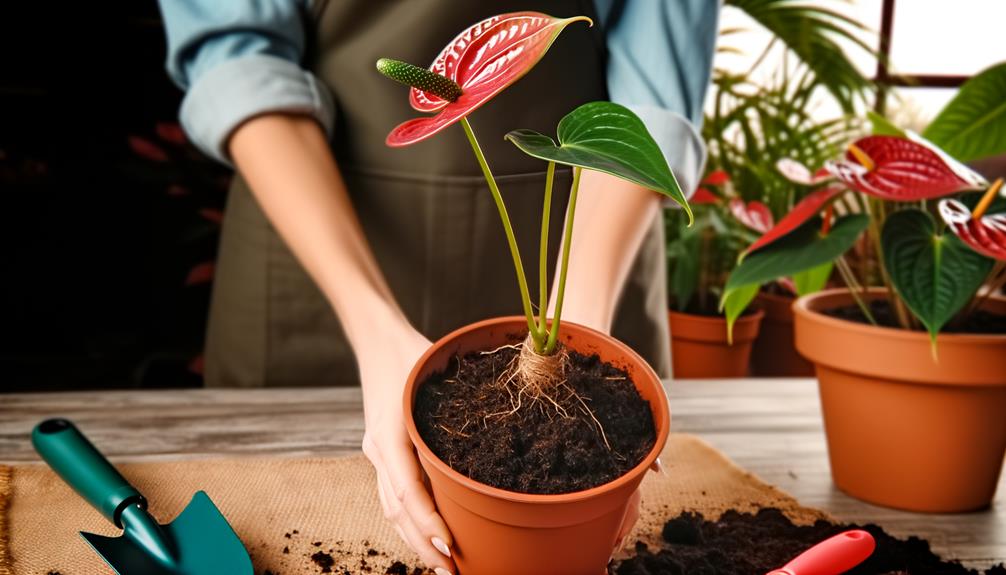
When repotting your Anthurium Red Gunsal, select a pot with sufficient drainage holes to prevent waterlogging.
Use a well-draining soil mix composed of orchid bark, peat, and perlite to ensure best root aeration.
Repot every 1-2 years or when roots outgrow the current pot to maintain plant health.
Choosing Right Pot
Choosing the correct pot for your Anthurium Red Gunsal involves taking into account factors like drainage, pot size, and material to guarantee ideal growth conditions. You need a pot with excellent drainage to prevent waterlogging, essential for root health. Opt for a pot that’s 1-2 inches larger in diameter than the current one; this encourages new growth without overwhelming the plant.
- Drainage Holes: Confirm the pot has multiple drainage holes to facilitate water flow.
- Material Choice: Use breathable materials like terracotta for best moisture regulation.
- Pot Size: Avoid oversized pots, as they can retain excess moisture, causing root rot.
- Repotting Frequency: Repot every 1-2 years to refresh the growing medium and provide space for root expansion.
These choices will help your Anthurium thrive.
Best Soil Types
For best growth, your Anthurium Red Gunsal requires a well-draining, nutrient-rich soil mix that mimics its natural tropical environment. You should use a combination of orchid bark, peat moss, and perlite. This blend guarantees excellent aeration and moisture retention, essential for the plant’s root health.
When repotting, gently remove the Anthurium from its current pot and shake off excess old soil. Place it in a new container that’s one size larger, filling around the roots with your prepared soil mix. Firm the soil gently but don’t compact it; roots need space to breathe.
Water thoroughly after repotting, allowing excess water to drain freely. Regularly check soil moisture to keep it consistently damp but not waterlogged.
Pest and Disease Control
To effectively manage pest and disease control for your Anthurium Red Gunsal, regularly inspect the plant for signs of infestation or infection is essential. Look for yellowing leaves, distorted growth, or sticky residue, which may indicate pests like aphids, spider mites, or scale insects. Use a magnifying glass to detect tiny invaders and act promptly.
- Neem Oil: Apply neem oil to repel pests naturally. Mix according to package instructions and spray thoroughly.
- Insecticidal Soap: Use insecticidal soap for severe infestations. Ensure thorough coverage of leaves and stems.
- Isolate Infected Plants: Quarantine affected plants to prevent the spread of pests or diseases.
- Prune Damaged Parts: Remove and dispose of infected or infested leaves to maintain plant health.
Common Growing Issues
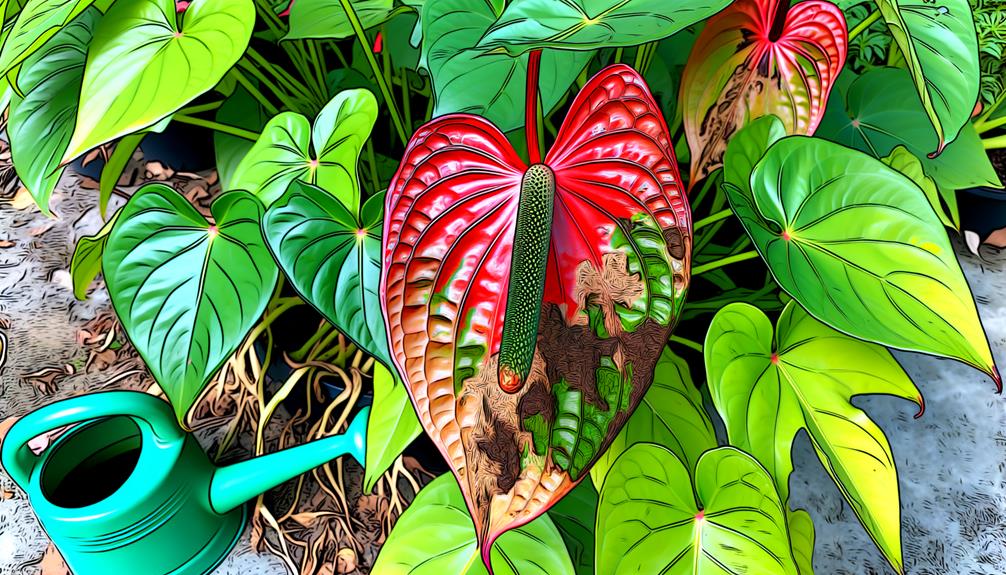
Many growers encounter common issues with Anthurium Red Gunsal, including improper watering, inadequate light, and insufficient humidity.
You must ensure the soil remains moist but not waterlogged; overwatering leads to root rot.
Place your plant in bright, indirect light to avoid leaf burn. If leaves turn yellow, it’s a sign of too much direct sunlight or insufficient water.
Maintaining humidity levels above 60% is essential; dry air causes leaf tips to brown. Mist the leaves regularly or use a humidifier.
If you notice slow growth, the plant might need more nutrients; consider a balanced fertilizer monthly during the growing season.
Conclusion
Caring for your Anthurium Red Gunsal is like nurturing a delicate, exotic bird. You’ve provided the ideal roost with the right light, kept its feathers vibrant with proper watering, and secured its song remains sweet with ideal humidity and temperature.
By pruning and repotting, you’ve upheld its vibrant plumage. Guarding it against pests and diseases is akin to shielding it from predators.
With your diligent care, your Anthurium will flourish, a sign of your precise and thoughtful stewardship.


